|
Normal school
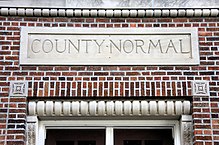 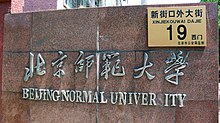 A normal school or normal college is an institution created to train teachers by educating them in the norms of pedagogy and curriculum. Many such schools have since been called teacher training colleges or teachers' colleges, but in Argentina and Mexico they continue to be called normal schools with student-teachers in the latter country being known as normalistas.[1] Many schools require a high school diploma for entry, and may be part of a comprehensive university. Normal schools in the United States, Canada, and Argentina trained teachers for primary schools, while in Europe, the equivalent colleges typically educated teachers for primary schools and later extended their curricula to also cover secondary schools. In 1685, St. Jean-Baptiste de La Salle established the Institute of the Brothers of the Christian Schools, founded what is generally considered the first normal school, the École normale, in Reims, Champagne, France. The term "normal" in this context refers to the goal of these institutions to instill and reinforce particular norms within students. "Norms" included historical behavioral norms of the time, as well as norms that reinforced targeted societal values, ideologies and dominant narratives in the form of curriculum. The first public normal school in the United States was founded in Concord, Vermont by Samuel Read Hall in 1823 to train teachers. In 1839, the first state-supported normal school was established by the Commonwealth of Massachusetts on the northeast corner of the historic Lexington Battle Green; it evolved into Framingham State University. The first modern teacher training school in China was established by educator Sheng Xuanhuai in 1895 as the normal school of the Nanyang Public School (now Shanghai Jiao Tong University) in Shanghai during the Qing dynasty.[2] Many comprehensive public or state-supported universities—such as UCLA[3] in the United States and Beijing Normal University in China—were established and operated as normal schools before they expanded their faculties and transformed themselves into research universities. Some of these universities, particularly in Asia, retain the word "Normal" in their name to highlight their historical purpose. In Canada, most normal schools were eventually assimilated into a university as its faculty of education, offering a one or two-year Bachelor of Education degree. Such a degree requires at least three, but usually four, years of prior undergraduate study. EtymologyThe term "normal school" originated in the early 17th century from the French école normale.[4] The French concept of an "école normale" was to provide a model school with model classrooms to teach model teaching practices to its student teachers.[citation needed] The children being taught, their teachers, and the teachers of the teachers were often together in the same building.[citation needed] Although a laboratory school, it was the official school for the children—primary or secondary.[citation needed]. Alternatively, the name derives from the objective of the institution to teach the practice or norms of pedagogy, i.e., teaching. EuropeEducating teachers was of great importance in the newly industrialized European economies which needed a reliable, reproducible and uniform work force. The process of instilling such norms within students depended upon the creation of the first uniform, formalized national educational curriculum. Thus, normal schools, as the teacher training schools, were tasked with both developing this new curriculum and developing the techniques through which teachers would instill these ideas, behaviors and values in the minds of their students.[5] GermanyIn Germany, schools of education only exist in the state of Baden-Württemberg. These schools prepare teachers for Grundschule (primary school) and secondary schools like Hauptschule and Realschule. Teachers for the Gymnasium are educated at universities. FinlandIn Finland, normal schools are under national university administration, whereas most schools are administered by the local municipality. Aspirant teachers do most of their compulsory trainee period in normal schools and teach while being supervised by a senior teacher. FranceIn France, a two-tier system developed after the Revolution: primary school teachers were educated at départemental écoles normales, high school teachers and university professors at the écoles normales supérieures. Nowadays all teachers are educated in an Institut national supérieur du professorat et de l'éducation (Graduate School of Teaching and Education). The écoles normales supérieures in France now mainly train researchers, who spend one year teaching in lycée. ItalyIn Italy, Normal Schools now are called Liceo delle Scienze Umane. The Scuola Normale Superiore di Pisa now focus mainly on training researchers. LithuaniaIn Lithuania, Lithuanian University of Educational Sciences (LEU), former Vilnius Pedagogical University (VPU) is the main teachers' training institution, established in 1935.[6] SerbiaIn Serbia, the first public normal school was founded in Sombor, Vojvodina, by Avram Mrazović in 1778 to train teachers.[7] In 2018, the Faculty of Education in Sombor celebrated 240 years since the founding of the first school for the education of Serbian teachers called Norma. It was a teacher training college at the beginning called Norma college before it was closed in 1811, and another school was opened in its place in 1812 in Szentendre under the Declaratory Rescript of the Illyrian Nation. The new institution was named Regium Pedagogium Nationis Illiricae or Royal Pedagogium Of The Illyrian-Serbian Nation (also referred to in Latin as Preparandium or Preparadija in Serbian) which eventually was relocated back to Sombor in 1816.[7] The Normal school – Teachers College is generally considered the first normal school or École normale in Sombor. The term "normal" in this case refers to "the goal of the institution to instill and reinforce particular norms within students". Also, these "norms included historical behavioral norms of the time, as well as norms that reinforced targeted societal values, ideologies and dominant narratives in the form of curriculum". For the longest time, this was the only academy for teachers' training in Serbian.[8] The first woman academician of the Serbian Academy of Sciences and Arts Isidora Sekulić, the poet Jovan Dučić, the composers Petar Konjović and Josif Marinković are just some of the alumni of Norma.[7] SpainIn Spain, the first public normal school was the Escuela Normal de Madrid, founded in Madrid in 1839. It was gradually integrated into the Complutense University of Madrid's Faculty of Education between 1991 and 1995. Later normal schools were founded in Zamora (1841), Segovia (1857), Salamanca and Valladolid. United KingdomIn the United Kingdom, teacher training colleges were once named as such, and were independent institutions.[9][10] Following the recommendation of the 1963 Robbins Report into higher education, teacher training colleges were renamed "Colleges of Education". Later in the 20th century some became a "College of Higher Education" or an "Institute of Higher Education".[11] For information about academic divisions devoted to this field outside of the United States and Canada, see Postgraduate Training in Education (disambiguation). A restructuring of higher education in the UK during the first two decades of the 21st century resulted in some establishments taking the status of "university". The University of Chester, founded by the Anglican church, traces its roots back to 1839 as the earliest training college in the United Kingdom. Others were also established by religious institutions, and most were single-sex until World War II. Since then, they have either become multi-discipline universities in their own right (e.g. Bishop Grosseteste University; University of Chester; Edge Hill University; St Mary's University, Twickenham; Newman University, Birmingham; Plymouth Marjon University; University of Winchester; University of Worcester; York St John University) or merged with another university to become its faculty of education (e.g. Moray House). In Wales, there were at least three institutions which included the word "Normal" in their name: Normal School, Brecon,[12] subsequently relocated to become Normal College Swansea[13] (where the academic and mathematician John Viriamu Jones was educated); and Normal College, Bangor (founded 1858), which survived until 1996, when it became part of University of Wales Bangor. The latter was one of the last institutions in the UK to retain the word "Normal" in its name. AsiaChina In Mainland China, the "normal school" terminology is still preserved in the official English names of former normal schools established in the late 19th and early 20th century. The Chinese term normal university (Chinese: 师范大学; pinyin: shīfàn dàxué, abbreviated 师大; shīdà) refers to a modern comprehensive university established as a normal school in the early twentieth century. These "normal universities" are usually controlled by the national or provincial government. In 1895, Qing banking tycoon and educator Sheng Xuanhuai gained approval from the Guangxu Emperor to establish the Nanyang Public School in Shanghai, China.[2] This comprehensive institution included the first normal school on the Chinese mainland. Since 1949, many former normal schools in China have developed into comprehensive research universities. As of 2012, Beijing Normal University and East China Normal University, both members of the national government's Project 985 program, have been ranked the top two among the mainland Chinese universities that originated as normal schools.[14] Indonesia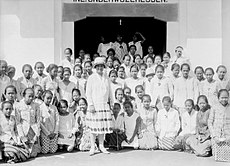 In Indonesia, there were specialised higher institutions to train teacher by educating them in the norms of pedagogy and curriculum. Indonesian government created crash program around 1950 as B-I/B-II/PGSLP course. In year 1954, the government opened the Teacher Education Higher Education Institutions (Perguruan Tinggi Pendidikan Guru, PTPG) in Batusangkar, Manado, Bandung, and Malang by Education and Culture Ministerial Decision No. 382/Kab Year 1954. Both courses were integrated to Teaching and Pedagogy Faculty at nearby university. Government Decision No. 51 Year 1958 integrate Pedagogy Faculty into Teaching and Pedagogy Faculty. In year 1962, Ministry of Basic Education established Teacher Education Institute (Institut Pendidikan Guru, IPG) for middle school teacher. In year 1963, B-I and B-II courses and IPG were merged into Teaching and Pedagogy Faculty under Ministry of Higher Education. In year 1963–1964, Teaching and Pedagogy Faculties were established as separate higher education institutions which were known as Teaching and Education Institutes (Institut Keguruan dan Ilmu Pendidikan, IKIP). Presidential Decision No. 93 Year 1999 allowed IKIP to develop non-educational sciences and marked the end of specialised teacher education higher institutions in general. Japan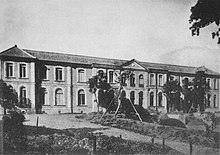 In Japan, the first normal school (師範学校 [ja]) was established at Yushima Seido, Tokyo in 1872.[15] Eventually, prefectural normal schools for primary teachers were established in all prefectures. Japanese-style normal schools were also established in the colonies of Taiwan, Korea, and Manchukuo under Japanese rule. In 1886, the Normal School Order (師範学校令) was promulgated and the Higher Normal School (高等師範学校) was established in Tokyo to train secondary teachers.[16] In 1929, Tokyo Arts and Sciences University (Tsukuba University) and Hiroshima Arts and Sciences University (Hiroshima University) were established for Normal School graduates.[17] During the postwar educational reform, normal schools were reorganized into universities' education faculties, arts and sciences faculty or universities of education. MalaysiaIn Malaysia, the Ministry of Education runs a total of 27 Institutes of Teacher Education (ITEs), which were formerly known as Teacher Training Colleges. These ITEs function primarily to educated both undergraduate and postgraduate teacher trainees. The ministry bureau responsible for overseeing them is the Teacher Education Division. The ITEs also run in-service teacher training and continuous professional development among qualified teachers. PhilippinesIn Naga City, the Philippines, one can find the oldest normal school for girls in the Far East, the Universidad de Santa Isabel. It is a sectarian school run by the Daughters of Charity. The first secular normal school was founded in 1901 by the Thomasites, the Philippine Normal School. It was converted into a college in 1949 and was elevated to its present university status in 1992 as the Philippine Normal University. In 2009, it was named National Center of Excellence for Teacher Education by virtue of Republic Act 9647. In Iloilo City, the West Visayas State University was originally established as a normal school in 1902; in 1994, it was recognized by the Philippines government as a Center for Teaching Excellence. Taiwan In Taiwan, three universities served as national normal universities historically. Located in Taipei (National Taiwan Normal University), Changhua (National Changhua University of Education), and Kaohsiung (National Kaohsiung Normal University), the schools primarily cultivates secondary school teachers and also trains teachers for preschool, elementary school, special education and other fields. These schools' missions have expanded since to make them de facto comprehensive research or liberal arts universities. NCUE didn't adopt the term "normal university" because its predecessor was named Taiwan Provincial College of Education, and it was unrelated to the subsequent trend of renaming education universities. Ten Taiwanese normal schools (Chinese: 師範學院; pinyin: shīfàn xuéyuàn, abbreviated 師院; shīyuàn, "normal colleges") were established under Japanese rule and at the end of World War 2, serving for primary school teacher's education. These were promoted as teachers' colleges and later granted university status in 2000s. It is distinguished under the name "Education University" from the "Normal University". Some of these were merged with comprehensive university, such as National Hualien University of Education, which were merged with National Dong Hwa University in 2007. Some of them were merged with professional university, such as Taipei Physical Education College was merged with Taipei Municipal University of Education to form the University of Taipei in 2013. OceaniaNew ZealandIn New Zealand, the term normal school can refer to a primary or intermediate school used for teacher training, such as the Epsom Normal Primary School (in Auckland), Kelburn Normal School, Palmerston North Intermediate Normal School, Papakura Normal School, Central Normal School in Palmerston North, and Tahuna Normal Intermediate School and George Street Normal School in Dunedin. They were associated with a teachers' training college, such as the Auckland College of Education and the Dunedin College of Education, which became colleges of education that trained secondary as well as primary and intermediate school teachers. North and South AmericaCanadaAlbertaThe Calgary Normal School in Calgary was initially located at 412 – 7 Street SW in Calgary in what is called the McDougall School founded shortly after Alberta became a province in 1905. Its history is part of the founding of the University of Calgary in 1966. Another Normal school was founded at Camrose (also called Rosehaven Normal school) in 1912. The Edmonton Normal School was opened in 1920 in Edmonton, Alberta. In 1945 all normal schools in Alberta were merged into the University of Alberta's Faculty of Education. British ColumbiaIn 1901, the first Provincial Normal School in British Columbia was opened in Vancouver. Classes commenced on 9 January 1901. In January 1909, the Provincial Normal school moved into a new facility and its own building located at 11th and Cambie (now part of City Square Mall). In 1915 a second Provincial Normal School opened in Victoria. Trainee teachers from greater Vancouver and the lower Mainland attended the Normal School in Vancouver. Students from Vancouver Island and students outside the Lower Mainland, that is, from the Upper Fraser Valley and communities in the interior of the province – enrolled in the Normal School in Victoria. That school was originally located in Victoria High School and later in its own building which is now part of Camosun College. In 1956 the responsibility for provincial teacher training was transferred to The University of British Columbia. Manitoba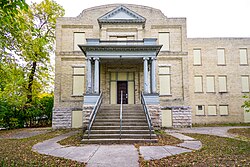 Central Normal School was founded in 1882 in Winnipeg. In 1905–06 a new building was constructed at 442 William Avenue. It was one of six Normal Schools in Manitoba, along with Brandon Normal School (1129 Queens Street, Brandon), Dauphin, Manitou, Portage la Prairie, and St. Boniface. Central Normal School moved to a facility in southwest Winnipeg in 1947. In the autumn of 1958, it was renamed the Manitoba Teachers' College. It was moved to the University of Manitoba in 1965, becoming its Faculty of Education. New BrunswickThe New Brunswick Teachers' College was a normal school in Fredericton, New Brunswick which granted teaching certificates. It was founded on February 10, 1848, as the Provincial Normal School with Joseph Marshall de Brett Maréchal, Baron d'Avray as the first principal. In 1947, the institution changed its name to the New Brunswick Teachers' College. It closed in 1973, and its staff were integrated into the faculties of education at the Université de Moncton and the University of New Brunswick. Newfoundland and LabradorThe Wesleyan Normal Day School was founded in 1852 by the Wesleyans under the Newfoundland School Society. This institution continued until 1901. In 1910, a normal school was established in St. John's by the Church of England which continued for a number of years. In 1921 the first non-denominational normal school was initiated and was discontinued in 1932. It was reorganized in 1934 as a department of the Memorial University College. In 1949, the institution's name was changed to Memorial University of Newfoundland. Nova ScotiaThe Nova Scotia Teachers College in Truro began in 1855 as the Provincial Nova Scotia Normal School opened in Truro, Nova Scotia. The school was closed in 1997 and the program essentially consolidated with other provincial universities including Acadia University, Mount St. Vincent, St. Francis Xavier, and Sainte-Anne. OntarioThanks largely in part to the effort of education reformer Egerton Ryerson, the Ontario Normal School system came into being beginning in Toronto in 1847. The London Normal School was located at 165 Elmwood Avenue in London, Ontario and commenced classes on February 1, 1900. By 1958, the building was no longer adequate and was moved to a new location on Western Rd. In 1973, London Teachers' College (as it was then called) (Elborn) merged with Althouse College to form the Faculty of Education at the University of Western Ontario.[18] The building is now a prominent area landmark.[19] The North Bay Normal School, a teacher training school, was established in 1909 in North Bay Ontario to meet the needs of teacher education in Ontario's North. The school was renamed North Bay Teachers' College in 1953, and became Nipissing University College's faculty of education in August 1973. After the university received a prestigious award in 2010, the Faculty of Education was renamed the Schulich School of Education. See Nipissing University. A school of pedagogy was formed in association with Toronto Normal School, offering advanced level courses suitable for high-school teachers. In 1897, the school was moved to Hamilton and renamed Ontario Normal College. The college closed in 1906 and the training was taken over by the faculties of education at the University of Toronto and Queen's University in Kingston.[20] The Ottawa Normal School was built in 1874 and opened in 1875. It was located at 195 Elgin Street. It was renamed the Ottawa Teachers' College in 1953, and was subsequently merged into the Faculty of Education of the University of Ottawa in 1974. The Peterborough Normal School in Peterborough was officially opened on September 15, 1908, and operated until the late 1960s. The Stratford Normal School was founded at 270 Water Street in 1908 in Stratford, Ontario. Its emphasis was primarily for training teachers for rural conditions. Its name was changed to Stratford Teachers' College in 1953 and closed its doors in 1973 having trained close to 14,000 teachers. The site was maintained, and was home to the Stratford Perth Museum for a number of years, being renamed the Discovery Centre. The museum moved to another location, however, and the building is now leased by the Stratford Shakespeare Festival, and has been named once again the Normal School Building.[21] Prince Edward IslandThe Prince Edward Island Normal School has its origin in 1856 on the grounds of Prince of Wales College in Charlottetown, P.E.I. Both it and St. Dunstan's University merged to form the present-day University of Prince Edward Island in 1969. QuebecThe first three Écoles normales were established in 1857, two for French speakers in Montréal and Québec, and a third one in Montréal for English speakers. More institutions were added in the following century. Religious communities were responsible for around 110 private normal schools, most of which were for girls, and universities had schools of education. Between 1963 and 1974, the system was ultimately phased out to be integrated into universities' Faculty of Education departments, specifically with new Université du Québec branches.[citation needed] SaskatchewanThe Saskatchewan Normal School, also once known as the Regina Normal School, was founded as early as 1890 in Regina moving into its first permanent structure in January, 1914. In 1964 it was transferred to University of Saskatchewan Regina Campus and in 1974 becoming part of the University of Regina. Another normal school was founded in the early 1920s in Moose Jaw and was later transferred into the Regina campus in 1959. The Saskatoon Normal School in Saskatoon was founded in 1912 and served until 1953. It has now been integrated with the Faculty of Education at University of Saskatchewan. JamaicaMico University College is the oldest teacher training institute in the English-speaking world outside of Europe. It was founded under Lady Mico Charity in 1834 by Sir Thomas Fowell Buxton "to afford the benefit of education and training to the black and coloured population." Today, it offers undergraduate and graduate degrees in a variety of education and liberal arts disciplines. Latin AmericaArgentinaIn Argentina, normal schools were founded starting in 1852, and still exist today and carry that name. Teachers' training is considered higher education and requires a high school diploma, but normal schools have the particularity of granting five-year teacher degrees for primary school or four year degrees for kindergarten, while at the same time hosting secondary, primary school students, and kindergarten and pre-school. Teachers-to-be do intense practical training in the schools annexed to the higher education section. This is the main difference with other teachers' training institutions called Instituto de Formación Docente and with universities that grant teaching degrees. BrazilThe first and oldest operating normal school in Brazil is the Escola Normal de Niterói, founded in Niterói in 1835 and renamed to Instituto de Educação Professor Ismael Coutinho in 1965. It is however not the oldest continually operating normal school in Latin America as it was disestablished during two separate periods from 1847–1862, and again from 1890–1931. Many Brazilian states later founded their own normal schools to train primary school teachers. ChilePerhaps the oldest continually operating normal school in Latin America is the Escuela Normal Superior José Abelardo Núñez, founded in Santiago, Chile, in 1842 as the Escuela de Preceptores de Santiago under the direction of the emininent Argentine educator, writer, and politician Domingo Faustino Sarmiento. The first normal school in the Dominican Republic was founded in 1875 by Puerto Rican educator and activist Eugenio María de Hostos. MexicoMexico founded early normal schools, such as the Escuela Normal de Enseñanza Mutua de Oaxaca (1824), the Escuela Normal Mixta de San Luis Potosí (1849), the Normal de Guadalajara (1881), and the Escuela Normal para Profesores de Instrucción Primaria (1887). The Mexican normal school system was nationalized and reorganized in the period after the Mexican Revolution (1910–1920) by the Secretaría de Educación Pública (Secretariat of Public Education) under José Vasconcelos in 1921. Many normal schools were founded in the postrevolutionary period to train the sons and daughters of peasants as teachers. In the 1960s, normal school students joined in the widespread student agitation to create systemic change in Mexico.[1] The 2014 mass kidnapping of normal school students from Ayotzinapa Rural Teachers' College was a major scandal in Mexico. Panama, Colombia and ParaguayIn Panama, the Escuela Normal Juan Demóstenes Arosemena was founded in Santiago de Veraguas, Panama in 1938. In Colombia, normal schools were primarily associated with women's religious schools although in modern times have admitted men, thus forming escuelas normales mixtas (mixed normal schools). In Paraguay, they are known as Instituto de Formación Docente. United StatesIn the United States, the former normal schools that survive in the 21st century have become colleges, usually requiring a high school diploma for entrance. Before the American Civil War public schools were elementary schools, and a normal school provided high school-level instruction as part of preparation for teaching the elementary common schools. Many American universities began as normal schools.[22][23][24][25][26][27] New EnglandNortheast1855 – Millersville Normal School, Millersville, Pennsylvania 1855 – The Paterson City Normal School, Paterson, New Jersey 1855 – New Jersey State Normal School, Trenton, New Jersey 1861 – Oswego Primary Teachers School, Oswego, New York Established as Oswego Normal School, the Oswego State Normal School was founded by Edward Austin Sheldon, and recognized as a state school in 1866 by New York State becoming the Oswego State Normal and Training School. The school was part of the training program Sheldon devised to introduce the Pestalozzi method of education to the schools of the city of Oswego, the first time the method had ever been used in the United States. Sheldon's school became Oswego State Teachers College in 1942, and was upgraded again to a liberal arts college in 1962, becoming known as Oswego State University. 1865 – Baltimore Normal School for Colored Teachers, Baltimore, Maryland 1866 – Keystone State Normal School, Kutztown, Pennsylvania 1866 – Maryland State Normal School, Baltimore, Maryland 1871 – Normal School, Buffalo, New York Buffalo State was founded in 1871 as the Buffalo Normal School before becoming the State Normal and Training School (1888–1927), the State Teachers College at Buffalo (1928–1946), the New York State College for Teachers at Buffalo (1946–1950), SUNY, New York State College for Teachers (1950–1951), the State University College for Teachers at Buffalo (1951–1959), the State University College of Education at Buffalo (1960–1961), and finally the State University College at Buffalo in 1961. 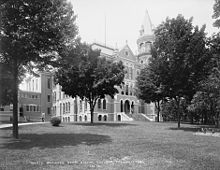 Midwest1853 – Michigan State Normal School, Ypsilanti, Michigan 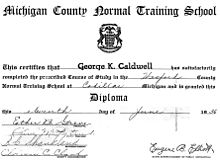 The first normal school west of the Appalachian Mountains in the United States was the Michigan State Normal School, now Eastern Michigan University. It was created by legislative action in 1849 and opened in Ypsilanti, Michigan, in 1853.[28] 1857 – Illinois State Normal University, Normal, Illinois The State of Illinois passed an act to establish a normal school on 18 February 1857, and proposals were submitted to locate the new school in Batavia, Bloomington, Peoria, and Washington (in Tazewell County). Bids were opened by the State Board of Education in Peoria on 7 May 1857 and the offer from Bloomington, Illinois, was accepted. The normal school was located near the village of North Bloomington, which later was renamed Normal in honor of the school. The school, originally known as Illinois State Normal University (ISNU), and also known as the Illinois State Teachers College,[29] is now known as Illinois State University. 1857 – Harris Teachers College, St. Louis, Missouri 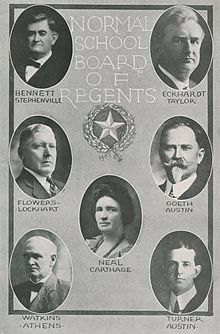 Harris–Stowe State University, now a state university in Missouri, was founded by the St. Louis public school system in 1857 and claims to be the oldest normal school west of the Mississippi River. The modern university is the result of the merger of the two normal schools in the area, Harris Teachers College, the older of the two institutions and segregated for white people only, and Stowe Teachers' College, which was segregated for black people only, following the Brown vs. BOE decision in 1954. 1858 – Winona State Normal School, Winona, Minnesota 1863 – Kansas State Normal Schools, Kansas  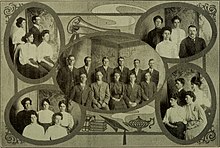 In 1863, the Kansas Legislature passed an act to establish the Kansas State Normal Schools, starting with the first in Emporia, Kansas, which eventually became Emporia State University Teachers College.[30] From 1870 through 1876, Leavenworth Normal School operated in Leavenworth, Kansas and from 1874 through 1876 Concordia Normal School operated in Concordia, Kansas, but the "miscellaneous appropriations bill of 1876" caused Leavenworth and Concordia to close and consolidated operations at the Emporia location.[31] Other normal schools were opened in Kansas including in 1902 the Western Branch of the Kansas Normal in Hays, Kansas, eventually becoming Fort Hays State University.[32] In 1904, a branch in Pittsburg, Kansas was opened as the Manual Training Auxiliary School, which eventually became Pittsburg State University.[33] 1865 – Indiana State Normal School, Terre Haute, Indiana  Established by the Indiana General Assembly on December 20, 1865; as the State Normal School, its core mission was to educate elementary and high school teachers. The school awarded its first baccalaureate degrees in 1908 and the first master's degrees in 1928. In 1929, the Indiana State Normal School was renamed the Indiana State Teachers College, and in 1961, was renamed Indiana State College due to an expanding mission. In 1965, the Indiana General Assembly renamed the college as Indiana State University in recognition of continued growth. 1866 – Platteville Normal School, Platteville, Wisconsin[34] 1867 – Nebraska State Normal School, Peru, Nebraska Nebraska State Normal School was chartered on June 20, 1867.[35][36] The action by the Nebraska legislature[35] made it the first state-supported college in Nebraska[36] with the first classes held on October 24, 1867.[35][36] The name changed to Nebraska State Teachers College at Peru in 1921, and in 1949 it changed to Peru State Teachers College.[37] The current name of Peru State College was adopted in 1963.[36] 1868 – Mankato Normal School, Mankato, Minnesota  Mankato Normal School was the second normal school in Minnesota. Students were usually 17–19 years old when they entered. The student body, which peaked at about 900 in 1920–21, was approximately three-fourths female. In 1921 the school evolved into Minnesota State University, Mankato. 1869 – Third State Normal School, St. Cloud, Minnesota Located in St. Cloud, the Third State Normal School was the third normal school established in Minnesota. It welcomed 50 students (40 women and 10 men) as well as 70 children for the model school. Ira Moore was the school's first principal (later president). It graduated its first class, numbering 15, in June 1871. It trained mostly teachers through the end of World War II and then branched out into other disciplines. It is today's St. Cloud State University. 1876 – Iowa State Normal School, Cedar Falls, Iowa 1888 – Moorhead Normal School, Moorhead, Minnesota 1892 - Central Michigan Normal School and Business Institute, Mt. Pleasant, Michigan 1894 – Springfield Normal School, Springfield, Missouri In 1906, the private school merged with the new state normal school becoming the Fourth District Normal School. The school moved to its current site with the completion of the building now called Carrington Hall in 1909. The school has evolved into a research university and is now Missouri State University.[40] 1899 – Ellendale State Normal and Industrial School This was one of the schools of higher learning provided for in North Dakota's 1889 constitution. Courses included American citizenship, cooking, woodworking, physical education, and others that together were offered as “a living symbol of democracy”.[41] OhioIn 1871, the Northwestern Ohio Normal School, which later became Ohio Northern University, was founded in Ada, Ohio. The Lowry Normal School Bill of 1910 authorized two new normal schools in Ohio—one in the northwestern part of the state (now Bowling Green State University) and another in the northeastern part (now Kent State University). 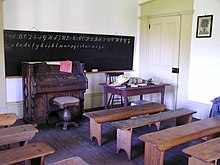 South1868 – Storer Normal School, Harpers Ferry, West Virginia 1872 – Florence Normal School, Huntsville, Alabama 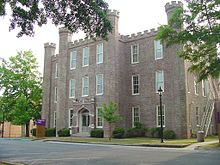 Florence Normal School is one of many state normal schools that developed into four-year state teachers' colleges and eventually into comprehensive state universities. This is the site of the first state-supported normal school established south of the Ohio River and now part of the University of North Alabama. 1873 – State Normal School, Normal, Alabama 1876 – Glasgow Normal School and Business College, Glasgow, Kentucky 1877 – Summer Normal School of the University of North Carolina 1879 – Sam Houston Normal Institute, Huntsville, Texas 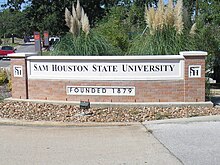 The first normal school in what is now considered the Southwest was opened in 1879 as Sam Houston Normal Institute (now Sam Houston State University). 1882 – Virginia Normal and Collegiate Institute (now Virginia State University) was founded, Petersburg, Virginia.[43] 1884 – Louisiana State Normal School, Natchitoches, Louisiana 1886 – Winthrop Training School, Rock Hill, South Carolina In 1886, the Peabody Education Board of Massachusetts, headed by Robert C. Winthrop, provided $1,500 to form the "Winthrop Training School" for white women teachers. That year the school opened its doors to twenty-one students in Columbia, South Carolina. Nine years later in 1895 it moved to Rock Hill. The school's name had changed in 1893 to "Winthrop Normal and Industrial College of South Carolina", reflecting its mission to prepare some students for industrial jobs. The college was segregated until 1964. It became fully coeducational in 1974. Evolving from a training school to a college with a four-year full curriculum, it also developed a graduate division. By 1992 it reflected this development, changing its name to Winthrop University. 1886 – State Normal School for Colored Persons, Frankfort, Kentucky 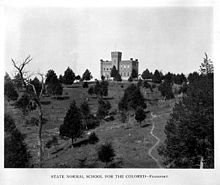 Chartered in 1886 as a state-supported school for training black teachers for the black schools of Kentucky, the school opened in 1887 with three teachers and 55 students. The school went through a series of changes of name and purpose, including becoming a land-grant college in 1890, in 1902 it was renamed Kentucky Normal and Industrial Institute for Colored Persons, in 1926 Kentucky State Industrial College for Colored Persons, in 1938 Kentucky State College for Negroes, in 1952 Kentucky State College, and finally in 1972 it became what it is known today as Kentucky State University.[44] 1887 – Croatan Normal School, Pembroke, North Carolina 1887 – Morehead Normal School, Morehead, Kentucky 1887 – State Normal College for Colored Students, Tallahassee, Florida 1899 – Appalachian State Normal School, Boone, North Carolina 1906 – Eastern Kentucky State Normal School No. 1, Richmond, Kentucky 1922 – Murray State Normal School, Murray, Kentucky West1857 – California State Normal School, San Jose, California 1890 – Colorado State Normal School, Greeley, Colorado 1910 – Western State College of Colorado, Gunnison, Colorado 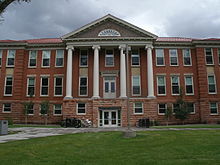 State Senator A. M. Stevenson,[50] Colorado, 1885 introduced a bill for a State Normal School. The bill was rejected. The bill revived in 1896. State Representative C. T. Rawalt[51] succeeded in appropriating $2,500 for land in 1901. Gov. James B. Orman approved the bill April 16, 1901. Trustees were elected and plans made in Gunnison, Colorado in the northeast part of town. Grounds were surveyed and fenced, shade trees added, drives laid out, and the lawns seeded. 12 cents remained of the $2,500 allotted. In 1903 a bill for $18,000 for maintenance was vetoed by Gov. J. H. Peabody. On May 5, 1909, $50,000 was appropriated. On October 25, 1910, the cornerstone of North Hall was laid for the State Normal School of Colorado. C. A. Hollingshead[52] was principal of the two year normal advanced and four year normal elementary (High school).[53] In 1916 the name was changed to Western State College of Colorado. On August 1, 2012, John Hickenlooper enacted the new name Western State Colorado University, and in 2018 the current name of Western Colorado University was adopted. Other normal schools in the US
See also
References
Bibliography
See alsoExternal linksLook up normal school in Wiktionary, the free dictionary.
|